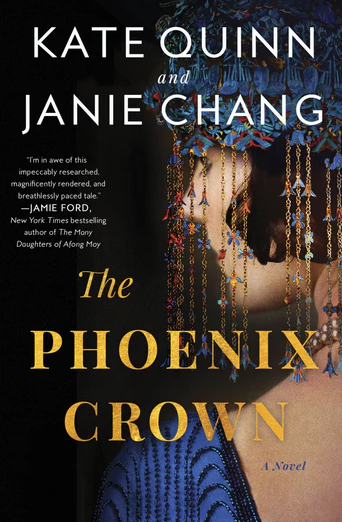The Phoenix Crown: A Novel
- By Kate Quinn and Janie Chang
- William Morrow Paperbacks
- 400 pp.
- Reviewed by Jennifer Bort Yacovissi
- March 25, 2024
Veteran authors team up to deliver a suspenseful, ripped-from-reality historical mystery.

After finishing any Kate Quinn novel, such as The Diamond Eye or The Alice Network, I look forward to reading her endnotes describing how much of the story was based on real-life events, however improbable they might seem. The notes at the end of The Phoenix Crown are just as illuminating, explaining that Quinn had carried the idea for a San Francisco earthquake story for years and was the one to approach her friend Janie Chang, author of Dragon Springs Road, The Porcelain Moon, and other novels, with the idea of writing the book together.
(An aside: It stuns me to consider what it must take to write a well-executed novel with another person, though Quinn has done it quite a few times, often with more than one co-author. But I was one of those people who always hated group projects in school, so I’m probably not a great judge.)
The result of this partnership is a deeply researched, richly rendered story of four women — a botanist, an opera singer, a clothing designer, and a painter — brought together in 1906 in the bustling young city of San Francisco.
Gemma Garland is in town to make her debut with the Metropolitan Opera traveling company in the chorus of “Carmen,” featuring the great Enrico Caruso, at the Grand Opera House. Having suffered a setback in New York, she is supposed to find lodging and comfort with her dearest friend, Nellie Doyle, only to discover that Nellie has decamped to parts unknown.
Instead, Gemma meets the real-life Alice Eastwood, curator of botany at the California Academy of Sciences, who rents a room in the same Nob Hill boardinghouse where Nellie had resided until six weeks before. Alice relates that Nellie, whom she knew by one of Nellie’s many invented names, had been staying there less frequently before she disappeared entirely, and that “there may also have been a man involved.”
Meanwhile, as the calendar and clock count down the days, hours, and minutes to disaster, we also meet Feng Suling (whose family name, in a lovely touch, means “phoenix”). Suling works in her late parents’ laundry and also as a seamstress, but she is a master of intricate embroidery. She is under the not-so-tender care of Third Uncle, her father’s ne’er-do-well younger brother, who is driving the laundry into ruin and planning to marry — sell — Suling off to an older man who was once in love with her mother. For her part, Suling is pining for Reggie, a secret lover who has proved faithless, leaving her (so it seems) without a backward glance.
Rounding out the main players is the enigmatic Henry Thornton, a fabulously wealthy entrepreneur who spends his money establishing himself as a patron of the arts. His collection of Asian artwork includes a magnificent headdress called the Phoenix Crown. An opera lover, he offers Gemma — painfully aware that, at 32, her soprano voice is peaking but her career is not — a business deal in which she will make her Met debut not in the chorus but as the star.
The tension ratchets up for readers, who know the big bang is coming, at the same time we wonder how Suling will join forces with the others, and the mystery deepens as to what’s happened to Nellie. There’s background chatter, too, about a Pinkerton detective who has gone missing. Something malevolent is afoot.
The authors deliver a tautly interwoven plot in which the earthquake and subsequent devastating fires serve to set up the final third of the story, in which our reunited team of talented, intelligent women implement their plan to bring those malevolent forces to justice.
At the same time, we’re treated to an immersive class in opera (Quinn once trained as “a high lyric soprano like Gemma” and based many of that character’s biographical details on those of her college voice professor) and learn much of the compelling true biography of botanist Eastwood. Making a recurring appearance is the Queen of the Night, which is both an opera that highlights Gemma’s range and a rare plant that flowers infrequently and only after dark.
Fully organic to the story is an exploration of the multiple layers of racism piled onto Chinese immigrants and their descendants like Suling, born in the U.S. but with few rights of citizenship. For readers unfamiliar with the Chinese Exclusion Act of 1882, the novel illustrates how its prohibition against virtually all Chinese immigration led to a host of issues that fed into white culture’s racist views of Chinese residents. At the same time, none of that vitriol lessened San Francisco elites’ hunger for Chinese fashion, artwork, and objects, many looted from sites in China.
The Phoenix Crown is a satisfying historical mystery that’s sure to drive readers to think, “Just one more chapter,” as the clock ticks late into the night. Here’s hoping Quinn and Chang join forces again in the near future.
Jennifer Bort Yacovissi’s debut novel, Up the Hill to Home, tells the story of four generations of a family in Washington, DC, from the Civil War to the Great Depression. Her short fiction has appeared in Gargoyle and Pen-in-Hand. Jenny reviews regularly for the Independent and serves on its board of directors as president. She has served as chair or program director of the Washington Writers Conference since 2017, and for several recent years was president of the Annapolis chapter of the Maryland Writers’ Association. Stop by Jenny’s website for a collection of her reviews and columns, and follow her on Twitter/X at @jbyacovissi.

